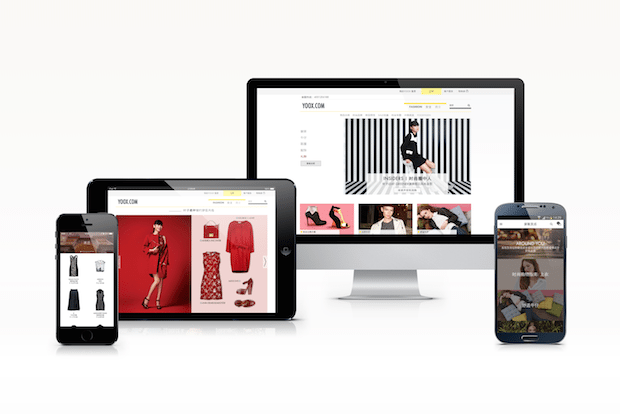
Yoox unveiled its mobile app for the China market in February 2015. (Courtesy Image)
As China’s booming e-commerce market rapidly expands, it’s also in the midst of a mobile revolution that’s taking hold at a fast and furious rate. With mobile sales on pace to eclipse those on PC any day now, luxury brands need to develop their China mobile game plan now more than ever—if they haven’t already.
Growth rates of mobile sales in China have not only been massive, they’ve been putting m-commerce on track to become the dominant platform for online purchases in the country. According to iResearch, the first quarter of 2015 saw a staggering 168.3 percent year-on-year increase in mobile sales for a total value of 362.34 billion RMB (about US$58.4 billion). Quarterly growth rates were even higher over the last few quarters, reaching 218.3 percent in Q4 of 2014.
As a result, we’ve seen the market share of mobile shopping rise from 25.9 percent of China’s total e-commerce market in the first quarter of last year to a current portion of 47.8 percent, putting it on track to surpass PC sales within the year if current rates continue.
This trend has caused many luxury retailers in China to rush to optimize their mobile experience by developing not only mobile-optimized online shops, but also by creating WeChat stores within their accounts and standalone mobile e-commerce apps. They’re also getting involved with online sales platforms including multi-brand luxury sellers and mass-market players like JD.com and Alibaba’s Tmall.
Online multi-brand luxury boutiques have been quick to embrace mobile in China. Chinese fashion e-tailer ShangPin unveiled its curated mobile app in 2013, and sees more than 40 percent of all of its sales on its mobile platforms, which include the app, its WeChat e-commerce page, and its mobile-optimized website. Yoox followed suit this year with its own mobile app, which came after its earlier development of a WeChat experience combining content, commerce, and social media. Meanwhile, Mei.com (formerly Glamour Sales) sees two thirds of its business from its three mobile platforms, and predicts that its business will be mainly mobile next year.
But it is actually mass-market platforms like Alibaba’s Tmall and competitor JD.com that take up the vast majority of mobile commerce sales in China. Like the PC e-commerce market, Alibaba unsurprisingly dominates mobile sales in China with 84.5 percent estimated market share in the first quarter of 2015. Its runner-up JD.com has been making slow, steady gains, now comprising 5.2 percent of all mobile sales in China.
Luxury brands have been reluctant to jump on board with these mass e-tailers, however, for fear that their discount-oriented identities will dilute a high-end image. Notable exceptions include Burberry, Calvin Klein, and a plethora of beauty brands on Tmall, and most recently, Luxottica and Sephora on JD.com. While brand image is a risk, there are several key benefits for brands signing up for these sites including massive market reach, leverage to fight China's rampant online gray market, the opportunity to read product reviews, access to a robust logistics network, and in the case of JD.com, access to WeChat e-commerce.
The most successful mobile sales platforms to date in China have gone above and beyond basic sales to provide users with interesting content and social experiences. For example, take Mogujie—one of the fastest-rising fashion e-commerce platforms on mobile. Although it’s geared mainly toward lower-priced fashion, the Pinterest-like functionality that allows users to create digital “collections” of clothes that can be purchased demonstrates the popularity of interactive experiences for Chinese mobile users. In addition, content curation and an omnichannel strategy will remain increasingly important for reaching China’s mobile luxury consumers.
While some brands still remain holdouts on e-commerce altogether (although Chanel and Fendi have finally given in this year), those that want to resonate with their Chinese customers need to embrace the country’s m-commerce revolution in creative and relevant ways. Whether brands choose to go with their own mobile platform, WeChat sales, multi-brand luxury sites, mass-market platforms, or all of the above, it’s going to be increasingly important for them to create a rewarding mobile experience for users.